
The Cucurbitaceae, also called cucurbits or the gourd family, are a plant family consisting of about 965 species in around 95 genera, of which the most important to humans are:

Mangifera is a genus of flowering plants in the cashew family, Anacardiaceae. It contains approximately 69 species, with the best-known being the Common Mango. The center of diversity is in subtropical and tropical South Asia and Southeast Asia, while the highest number of species occur in India. They are generally canopy trees in lowland rainforests, reaching a height of 30–40 m (98–131 ft).

Myosotis is a genus of flowering plants in the family Boraginaceae. The name comes from the Ancient Greek μυοσωτίς "mouse's ear", which the foliage is thought to resemble. In the northern hemisphere they are colloquially denominated forget-me-nots or scorpion grasses. The colloquial name "forget-me-not" was calqued from the German Vergissmeinnicht and first used in English in AD 1398 through King Henry IV of England. Similar names and variations are found in many languages. Myosotis alpestris is the official flower of Alaska and Dalsland, Sweden. Plants of the genus are commonly confused with Chatham Islands' forget-me-nots which belong to the related genus Myosotidium.

Cananga is a small genus of trees in the family Annonaceae: native to Indo-China and Malesia, bit introduced elsewhere. One of its species, Cananga odorata, is important as the source of the perfume ylang-ylang.
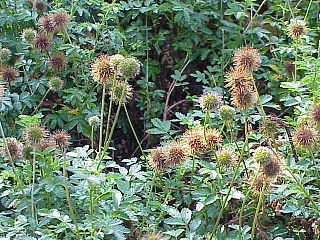
Acaena is a genus of about 60 species of mainly evergreen, creeping herbaceous perennial plants and subshrubs in the family Rosaceae, native mainly to the Southern Hemisphere, notably New Zealand, Australia and South America, but with a few species extending into the Northern Hemisphere, north to Hawaii and California.

Muehlenbeckia or maidenhair is a genus of flowering plants in the family Polygonaceae. It is native to the borders of the Pacific, including South and North America, Papua New Guinea and Australasia. It has been introduced elsewhere, including Europe. Species vary in their growth habits, many being vines or shrubs. In some environments, rampant species can become weedy and difficult to eradicate.
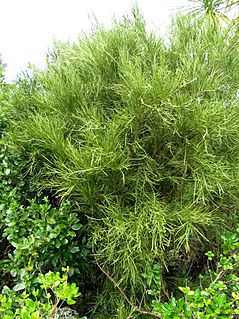
Carmichaelia is a genus of 24 plant species belonging to Fabaceae, the legume family. All but one species are native to New Zealand; the exception, Carmichaelia exsul, is native to Lord Howe Island and presumably dispersed there from New Zealand.

Astereae is a tribe of plants in the family Asteraceae that includes annuals, biennials, perennials, subshrubs, shrubs, and trees. Plants within the tribe are present nearly worldwide divided into 170 genera and more than 2,800 species, making it the second-largest tribe in the family behind Senecioneae. They are found primarily in temperate regions of the world.

Thryptomene is a genus of small shrubs in the family Myrtaceae described as a genus in 1838. The entire genus is endemic to Australia.

Pentaspadon is a genus of plants in the family Anacardiaceae.
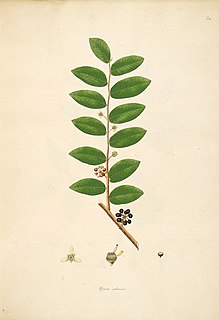
Polyalthia is a genus of flowering plants in the family Annonaceae. There are approximately 90 species distributed from Africa to Asia and the Pacific.

Dyera is a genus of tropical trees up to 80 m in height. They are in family Apocynaceae, native to southeast Asia. It was first described as a genus in 1882, by Joseph Dalton Hooker.
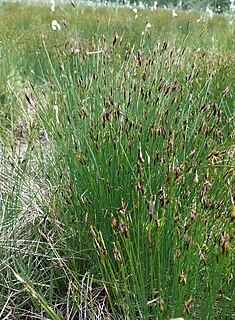
Schoenus is a genus of sedges. Plants of this genus mainly occur in Australia and Southeast Asia with some species widespread in scattered locations in Europe, Asia, Africa, and the Americas. Bogrush is a common name for these plants.
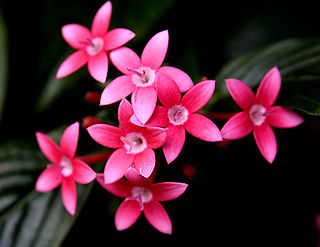
Knoxieae is a tribe of flowering plants in the family Rubiaceae and contains about 131 species in 16 genera. Its representatives are found in Tropical and Southern Africa, the islands in the Western Indian Ocean, the Arabian Peninsula, Tropical and Subtropical Asia, and Northern Australia.

Holigarna is a genus of trees in the subfamily Anacardioideae of the cashew and sumac family Anacardiaceae. They grow naturally in India, Bangladesh and Indo-China. This is a poisonous tree if contacted it would irritate skin chemically and result in irreversible skin damage. Smoke from burning this wood is dangerously disabling.

Trochomeria is a genus of flowering plants belonging to the family Cucurbitaceae.
Androstoma is a genus of flowering plants belonging to the family Ericaceae.
Bythophyton is a genus of flowering plants belonging to the family Plantaginaceae.
Dactyliandra is a genus of flowering plants belonging to the family Cucurbitaceae.
Nesogenes is a genus of flowering plants belonging to the family Orobanchaceae.















